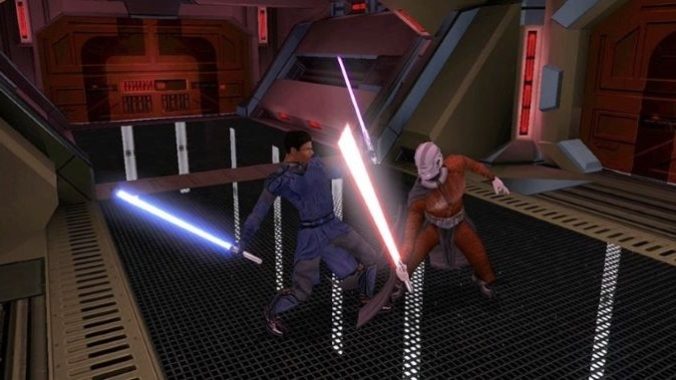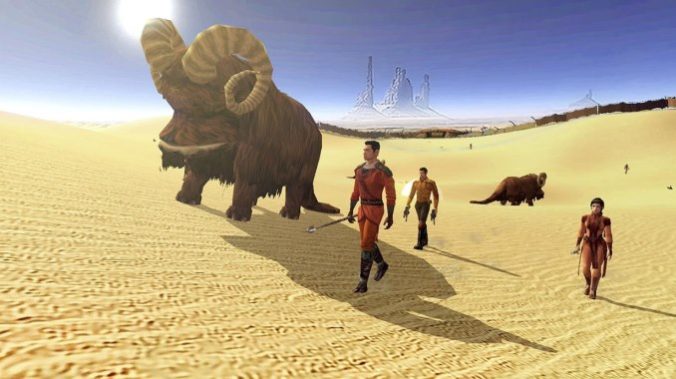Star Wars: Knights of the Old Republic’s Thematic Depth Helped Invent the Cinematic RPG

20 years after its first release, Star Wars: Knights of the Old Republic (KotOR) remains among the best things to come out of Lucasfilm’s sprawling space fantasy franchise. I remember seeing the game on my dad’s desk and opening the case, reading the manual, puzzling over this potential new Star Wars experience. I remember the surprise and excitement of watching the opening crawl. KotOR and its sequel sit alongside the original trilogy in defining this franchise for me—potential, related disappointments, and occasional surprises. Born too late to come up on Baldur’s Gate (my only brief experience was Dark Alliance), this is where BioWare got their hooks in me. Other experiences expanded my perspective, but Knights of the Old Republic set a firm baseline of expectation for role-playing games, which I came to see as the core game genre before its components were grafted onto every mass market shooter.
While there have been exemplary efforts since (like Obsidian’s unfinished excellent sequel Knights of the Old Republic II—The Sith Lords and the recent Disney+ series Andor), BioWare’s classic has seldom been matched by Star Wars in any format since its release. Simultaneously, KotOR was a bridge in BioWare’s concept of roleplaying game design with Baldur’s Gate and Baldur’s Gate II on one side and Jade Empire, Mass Effect, and Dragon Age (which hewed slightly closer to the older games’ setting and gameplay) on the other. Knights of the Old Republic adapted and adjusted familiar Star Wars iconography and narrative themes to a new timeline far away from the mainstream corporate canon.
With Knights of the Old Republic, BioWare established a cinematic focus as one of the major genre expressions of contemporary AAA/blockbuster “Western” RPGs, contrasting with the sandbox style of Bethesda’s Elder Scrolls series (where the previous year’s Morrowind was an early pillar). BioWare’s new presentation style heavily utilized pre-rendered and in-engine cutscenes. They reiterated the narrative focus and cinematic style through a closer third-person gameplay camera than Baldur’s Gate’s overtop isometric view. Much as the Baldur’s Gate games were among those adapting Dungeons & Dragons, KotOR adapted the d20 roleplaying combat system of the tabletop Star Wars Roleplaying Game into real time with pause (RTWP) combat. Bridging the gameplay and the cinematic presentation was the choice-filled dialog that guided the story and allowed players to influence outcomes. Moreover, players designed the character’s physical presentation and skillset, and defined them through choices that affect the storyline—components core to the genre which have infrequently reappeared in Star Wars games.
Knights of the Old Republic helped develop and articulate ideas that Star Wars was and still struggles with. Governmental corruption, the fallibility of heroes and institutions, and, perhaps most notably, prejudice, are among themes that might seem obvious inclusions in an interplanetary military space fantasy, but which have much more room to be explored in a 40-hour RPG than a two-hour film.
From the game’s start on the segregated city planet of Taris through its exploration of Dantooine (a farming planet that houses a Jedi enclave), Kashyyyk (home to the wookies), Manaan (an ocean planet home to a pharmaceutical resource), Korriban (the Sith graveyard-homeworld), and Tattooine (the desert planet where Star Wars began), KotOR explores how class interacts with identity, and how prejudicial laws harm people. KotOR focuses on a lower- and under-city on the introductory world, exploring broken governance and how deprivation brings about resourcefulness and disrupts and enables community, while also delving into spirituality’s role in these communities. On Dantooine, players encounter refugees-turned-mercenaries and aristocratic blood feuds. On Kashyyyk and Korriban, corporate largesse and exploitation are on display, as the double-dealing profit-driven Czerka corporation profits from slavery and partners with the galaxy-ravaging Sith. While the moral calculus of the alignment meter typically relies on cut-and-dry decisions between overwhelming generosity and abject cruelty, the game engaging with these themes seems retrospectively brave and cutting-edge. And the open-endedness provided by putting the story in the player’s hands was never a problem because of the story’s distance from the film series.
